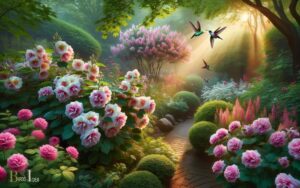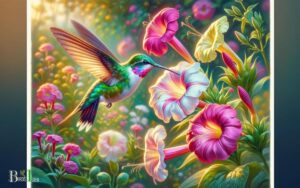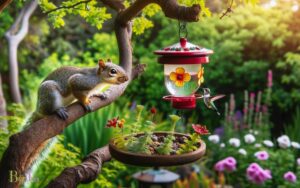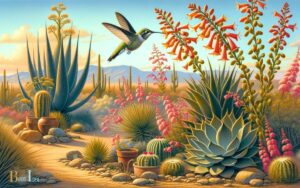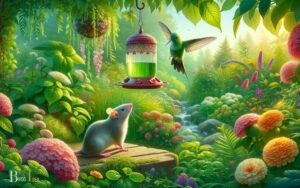Does Hummingbird Mint Attract Hummingbirds? Yes!
Yes, Hummingbird Mint (Agastache), does attract hummingbirds. This perennial, also known as Hyssop or Anise Hyssop, features brightly colored flowers and a minty scent that make it particularly appealing to these tiny birds.
Hummingbird Mint is a favorite among gardeners looking to attract hummingbirds.
This plant is characterized by:
Examples of the Agastache species known for attracting hummingbirds include Agastache ‘Rupestre’, Agastache cana, and Agastache ‘Blue Fortune’.
Incorporating Hummingbird Mint into your garden not only adds aesthetic appeal with its vivid blossoms but also invites the delightful sight of hummingbirds feeding and interacting with the environment.
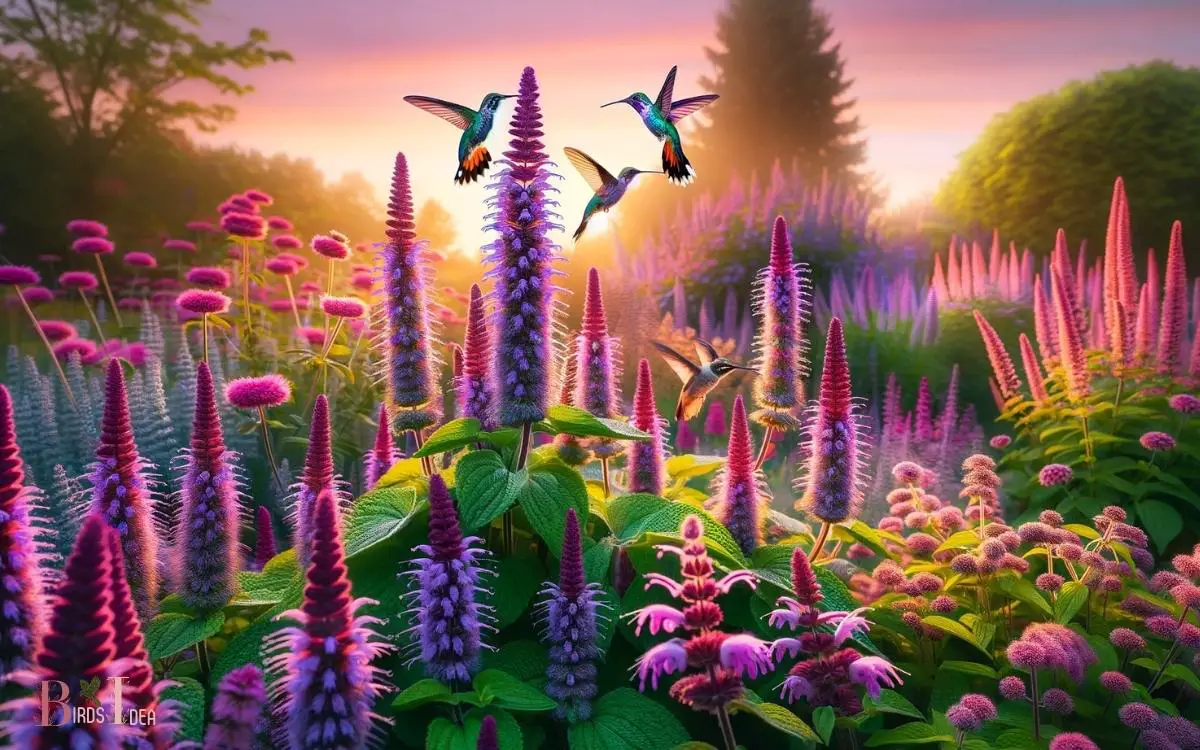
Key Takeaway
What Is Hummingbird Mint?
Attracting hummingbirds, hummingbird mint is a fragrant, nectar-producing plant that is known for its tubular flowers and ability to attract pollinators.
Hummingbird mint, also known as agastache, belongs to the mint family and is native to North America.
It is characterized by its long blooming period, typically from mid-summer to early fall, making it an excellent choice for attracting and sustaining hummingbirds in gardens.
The plant’s aromatic foliage, which releases a pleasant minty fragrance when brushed against, adds to its appeal.
With its vibrant, showy flowers and adaptability to various soil types and climates, hummingbird mint is a popular choice for both experienced and novice gardeners seeking to create a hummingbird-friendly environment.
Characteristics of Hummingbird Mint
Hummingbird mint, also known as agastache, possesses characteristics that make it highly attractive to hummingbirds.
Its vibrant and fragrant flowers are irresistible to these tiny birds, making it a favorite in many gardens.
Additionally, its drought-tolerant nature and ability to attract various pollinators further enhance its appeal to gardeners.
Hummingbird Mint Nectar Production
Hummingbird mint, also known as Agastache, produces nectar in specialized glands called nectaries located within its flowers.
These nectaries secrete a sweet liquid rich in sugars, amino acids, and other compounds that serve as a food source for hummingbirds.
The production of nectar is influenced by various factors, including environmental conditions such as sunlight, temperature, and soil quality.
Hummingbird mint has adapted to attract hummingbirds, which play a crucial role in its pollination.
The nectar serves as a reward for the hummingbirds, encouraging them to visit the flowers, inadvertently transferring pollen and facilitating the plant’s reproductive process.
The quantity and quality of nectar production can vary among different species and individual plants, influencing their attractiveness to hummingbirds.
Drought-Tolerant and Fragrant
Although known for attracting hummingbirds, hummingbird mint is also prized for its drought-tolerant nature and fragrant foliage.
This perennial plant, also known as agastache, thrives in dry conditions, making it an ideal choice for water-wise gardens.
Its ability to withstand drought makes it low-maintenance and suitable for areas with limited water availability.
Additionally, hummingbird mint’s fragrant foliage adds to its allure, releasing a pleasant aroma when brushed against or crushed.
The aromatic leaves not only contribute to the plant’s ornamental value but also have practical uses, such as in herbal teas or potpourri.
With its drought tolerance and fragrant qualities, hummingbird mint offers not only aesthetic appeal but also resilience in challenging growing conditions, making it a valuable addition to any garden.
Ideal for Pollinators
Many gardeners appreciate the fact that hummingbird mint is a favorite among pollinators due to its abundance of nectar.
The vibrant tubular flowers of the hummingbird mint plant act as a magnet for various pollinators such as bees, butterflies, and hummingbirds.
Its long blooming period, usually from midsummer to fall, provides a consistent nectar source for these beneficial insects and birds.
Hummingbird mint’s high nectar production and sweet fragrance make it an ideal addition to any pollinator garden.
Its drought-tolerant nature also ensures that it can thrive in various environments, further enhancing its appeal to pollinators.
Understanding the characteristics that make hummingbird mint attractive to pollinators can help gardeners create a welcoming habitat for these essential creatures.
This attraction to pollinators sets the stage for exploring hummingbirds’ specific affinity for hummingbird mint.
Hummingbirds’ Attraction to Hummingbird Mint
Hummingbirds are particularly drawn to the nectar-rich blooms of hummingbird mint, making it a popular choice for attracting these small, agile birds to gardens and yards.
The vibrant, tubular flowers of hummingbird mint are like a beacon for hummingbirds, enticing them with their rich nectar and bright colors.
When a hummingbird hovers over the blooms, delicately sipping nectar, it’s a mesmerizing sight that brings joy to any observer.
The way the tiny birds flit from flower to flower, their iridescent feathers catching the sunlight, creates a sense of wonder and enchantment.
Witnessing these graceful creatures in action, gracefully darting through the air, is a truly magical experience for nature lovers.
Planting and Caring for Hummingbird Mint
Attracting hummingbirds with its nectar-rich blooms, planting and caring for hummingbird mint requires attention to specific growing conditions and maintenance tasks.
Hummingbird mint, also known as agastache, thrives in well-drained soil and full sunlight. It is important to water the plant regularly, especially during dry periods, but also ensure that the soil does not become waterlogged.
Below is a table summarizing the key care requirements for hummingbird mint:
| Growing Conditions | Maintenance Tasks |
|---|---|
| Well-drained soil | Regular watering |
| Full sunlight | Avoid waterlogging |
By providing the right conditions and care, hummingbird mint can flourish and attract beautiful hummingbirds to your garden.
When considering other plants to attract hummingbirds, it’s essential to explore a variety of nectar-producing flowers and shrubs.
Other Plants to Attract Hummingbirds
When considering other plants to draw in hummingbirds, it’s important to explore a variety of nectar-producing flowers and shrubs.
Some great options to attract these delightful birds include:
- Trumpet Vine: This vigorous vine produces long, trumpet-shaped flowers that hummingbirds find irresistible.
- Bee Balm: With its vibrant colors and rich nectar, bee balm is a favorite of hummingbirds.
- Salvia: Hummingbirds are drawn to the tubular flowers of various salvia species, providing them with ample nectar.
- Lupine: The tall spires of lupine flowers not only add beauty to your garden but also serve as a food source for hummingbirds.
These plants, among others, can create a welcoming environment for hummingbirds in your garden.
Tips for Attracting Hummingbirds to Your Garden
When attracting hummingbirds to your garden, consider planting hummingbird-friendly flowers like salvia, bee balm, and trumpet vine.
Providing fresh nectar sources, such as hanging feeders or natural nectar-producing plants, is crucial for sustaining these tiny birds.
Creating a welcoming environment with perches, water features, and shelter will also encourage hummingbirds to visit and stay in your garden.
Planting Hummingbird-Friendly Flowers
Hummingbirds are attracted to a variety of colorful, nectar-rich flowers in gardens.
To attract these beautiful creatures to your garden, consider planting the following hummingbird-friendly flowers:
- Bright red or orange tubular flowers, such as trumpet vine or bee balm, which are known to catch the attention of hummingbirds.
- Flowers with long bloom periods, like salvia and coneflowers, providing a consistent nectar source for hummingbirds.
- Native wildflowers, such as columbine or penstemon, which not only attract hummingbirds but also support local ecosystems.
- Fragrant flowers like nicotiana or phlox, adding an extra sensory element to entice hummingbirds.
By planting these flowers, you can create an inviting environment for hummingbirds in your garden, providing them with a diverse and abundant nectar supply.
Providing Fresh Nectar Sources
To ensure a consistent nectar supply for hummingbirds in your garden, it’s essential to provide fresh nectar sources that align with their preferences and needs.
Hummingbirds are attracted to the color red, so using a feeder with red accents or placing red ribbons nearby can help draw them in.
It’s important to regularly change the nectar, especially in hot weather, to prevent fermentation and mold growth.
A simple nectar recipe consists of four parts water to one part sugar, boiled and then cooled before filling the feeder.
Additionally, planting a variety of nectar-rich flowers that bloom at different times can supplement the hummingbirds’ diet.
By offering a range of fresh nectar sources, you can create an inviting environment that keeps these delightful birds returning to your garden.
Creating a Welcoming Environment
In creating a welcoming environment for hummingbirds in your garden, it’s essential to provide a variety of nectar-rich flowers and maintain fresh nectar sources.
To attract these delightful birds, consider the following tips:
- Plant a diverse selection of native flowers to provide a continuous nectar supply.
- Incorporate a water feature, such as a small fountain or birdbath, to offer drinking and bathing opportunities.
- Hang bright red feeders in various areas of the garden to catch their attention.
- Avoid using pesticides and herbicides to ensure a safe and healthy environment for hummingbirds.
Conclusion
Hummingbird mint is a beautiful and fragrant plant that can attract hummingbirds to your garden.
Interestingly, studies have shown that hummingbirds are more likely to visit gardens with a variety of flowering plants, so incorporating other nectar-rich flowers alongside hummingbird mint can increase the likelihood of attracting these delightful birds.
By planting and caring for hummingbird mint and other hummingbird-friendly plants, you can create a welcoming environment for these fascinating creatures.

